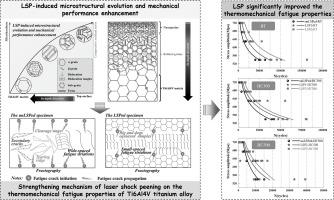International Journal of Fatigue ( IF 5.7 ) Pub Date : 2023-03-17 , DOI: 10.1016/j.ijfatigue.2023.107631 Zhao Wang , Wanting Zhou , Kaiyu Luo , Haifei Lu , Jinzhong Lu

|
In this study, the role of laser shock peening (LSP) on the thermomechanical fatigue properties of Ti6Al4V titanium alloy was investigated. The effects of LSP with different coverage layers on the microstructural evolution, residual stresses distribution, and thermomechanical fatigue lives were systematically analyzed by scanning electron microscopy, transmission electron microscope, residual stresses tests, microhardness tests, and thermomechanical fatigue tests. Results showed that the thermomechanical fatigue lives of the LSP1 and LSP2 specimens at room temperature increased by 48.00 % and 114.95 %, respectively. While the fatigue life of the LSP2 specimen increased by 68.91 % even under high-temperature heat cycle. Meanwhile, the locations of crack initiations in the LSPed specimens were significantly shifted to the sub-surface with a smaller fatigue initiation region area compared to the unLSPed specimen. Furthermore, the fracture surface was essentially occupied by equiaxed dimples and small-spaced fatigue striations. LSP-induced considerable depth of severe plastic deformation in the near-surface of Ti6Al4V titanium alloy, generating gradient compressive residual stresses, high-density dislocation structures (dislocation lines, dislocation tangles, dislocation walls, and dislocation cells), and grain refinement (nanograins and nanotwins). These three main factors contributed to inhibiting the sprouting and propagation of cracks during the thermomechanical fatigue tests and played a primary role in improving the thermomechanical fatigue properties.
中文翻译:

激光冲击强化Ti6Al4V钛合金热机械疲劳性能的机理
在本研究中,研究了激光冲击强化 (LSP) 对 Ti6Al4V 钛合金热机械疲劳性能的影响。通过扫描电子显微镜、透射电子显微镜、残余应力测试、显微硬度测试和热机械疲劳测试,系统地分析了具有不同覆盖层的LSP对显微组织演变、残余应力分布和热机械疲劳寿命的影响。结果表明,LSP1 和 LSP2 试样在室温下的热机械疲劳寿命分别提高了 48.00 % 和 114.95 %。而即使在高温热循环下,LSP2 试样的疲劳寿命也增加了 68.91%。同时,与未进行 LSP 处理的试样相比,经 LSP 处理的试样中裂纹萌生的位置显着转移到疲劳萌生区域面积较小的次表面。此外,断裂表面基本上被等轴韧窝和小间距疲劳条纹占据。LSP 在 Ti6Al4V 钛合金近表面引起相当大深度的严重塑性变形,产生梯度压缩残余应力、高密度位错结构(位错线、位错缠结、位错壁和位错胞)和晶粒细化(纳米晶粒)和纳米双胞胎)。这三个主要因素有助于抑制热机械疲劳试验中裂纹的萌生和扩展,对提高热机械疲劳性能起主要作用。











































 京公网安备 11010802027423号
京公网安备 11010802027423号